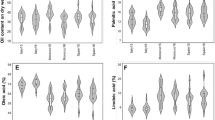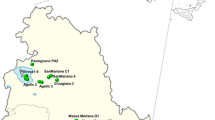Abstract
Selection for oil quality is commonly conducted at the latest stages of olive breeding programs, as oil quality traits are measured in extracted oils. At the initial stages of breeding, the number of genotypes is high and fruit production is low, which makes it difficult to conduct oil extraction. The objective of this research was to evaluate the feasibility of conducting selection for some important oil quality traits in olive by analyzing fruit flesh instead of extracted oils. Fatty acids, tocopherols, phytosterols, and squalene were measured in fruit flesh and extracted oils from 22 individual olive trees showing variability for oil quality traits. Correlation coefficients between analyses conducted on fruit flesh and extracted oils were r = 0.98 for the main fatty acids palmitic, oleic, and linoleic acid, r = 0.96 for tocopherol content, r = 0.89 for phytosterol content, r = 0.97 for squalene content, and r = 0.91 and 0.94 for the concentrations of the two main sterols β-sitosterol and Δ5-avenasterol, respectively. The results revealed that selection for the mentioned oil quality traits can be efficiently conducted through the analysis of fruit flesh instead of extracted oil, which facilitates selection on larger numbers of genotypes at the initial stages of olive breeding programs.





Similar content being viewed by others
References
Pérez-Jiménez F, Ruano J, Pérez-Martínez P, López-Segura F, López-Miranda J (2007) The influence of olive oil on human health: not a question of fat alone. Mol Nutr Food Res 51:1199–1208
Psaltopoulou T, Kosti RI, Haidopoulos D, Dimopoulos M, Panagiotakos DB (2011) Olive oil intake is inversely related to cancer prevalence: a systematic review and a meta-analysis of 13800 patients and 23340 controls in 19 observational studies. Lipids Health Dis 10:127
Boskou D (2009) Other Important Minor Constituents. In: Boskou D (ed) Olive oil minor constituents and health. CRC Press, Boca Raton, pp 45–54
Clodoveo ML, Hbaieb RH, Kotti F, Scarascia-Mugnozza G, Gargouri, M (2014) Mechanical strategies to increase nutritional and sensory quality of virgin olive oil by modulating the endogenous enzyme activities. Compr Rev Food Sci Food Safety 13:135–154
Pérez-Jiménez F, Ruano J, Pérez-Martínez P, López-Segura F, López-Miranda J (2007) The influence of olive oil on human health: not a question of fat alone. Mol Nutr Food Res 51:1199–1208
Ronco AL, De Stéfani E (2013) Squalene: a multi-task link in the crossroads of cancer and aging. Funct Foods Health Dis 3:462–476
Piironen V, Lindsay DG, Miettinen TA, Toivo J, Lampi AM (2000) Plant sterols: biosynthesis, biological function and their importance to human nutrition. J Sci Food and Agric 80:939–966
Plat J, Mensink RP (2005) Plant stanol and sterol esters in the control of blood cholesterol levels: mechanism and safety aspects. Am J Cardiol 96:15–22
Boskou D, Blekas G, Tsimidou M (2006) Olive Oil Composition. In: Boskou D (ed) Olive Oil. AOCS Press, Champaign, IL, Chemistry and Technology, pp 41–72
Galli F, Azzi A (2010) Present trends in vitamin E research. BioFactors 36:33–42
Shahidi F, Zhong Y (2010) Lipid oxidation and improving the oxidative stability. Chem Soc Rev 39:4067–4079
Eitenmiller R, Lee J (2004) Vitamin E. Food chemistry, composition, and analysis. Marcel Dekker, New York
Marmesat S, Velasco L, Ruiz-Méndez MV, Fernández-Martínez JM, Dobarganes C (2008) Thermostability of genetically modified sunflower oils differing in fatty acid and tocopherol compositions. Eur J Lipid Sci Technol 110:776–782
Warner K, Miller JF, Demurin Y (2008) Oxidative stability of crude mid-oleic sunflower oils from seeds with high γ- and δ- tocopherols levels. J Am Oil Chem Soc 85:529–533
Rallo L, El Riachy M, Rallo P (2011) The time and place for fruit quality in olive breeding. In: Jenks MA, Bebeli PJ (eds) Breeding for fruit quality. Wiley, Hoboken, pp 323–347
León L, Beltrán G, Aguilera MP, Rallo L, Barranco D, De la Rosa R (2011) Oil composition of advanced selections from an olive breeding program. Eur J Lipid Sci Technol 113:870–875
Dabbou S, Rjiba I, Echbili A, Gazzah N, Mechri B, Hammami M (2010) Effect of controlled crossing on the triglyceride and fatty acid composition of virgin olive oils. Chem Biodivers 7:1801–1813
Garcés R, Mancha M (1993) One-step lipid extraction and fatty acid methyl esters preparation from fresh plant tissues. Anal Biochem 211:139–143
León L, Uceda M, Jiménez A, Martín LM, Rallo L (2004) Variability of fatty acid composition in olive (Olea europea L.) progenies. Spanish J Agric Res 2:353–359
Chun J, Lee J, Ye L, Exler J, Eitenmiller RR (2006) Tocopherol and tocotrienol contents of raw and processed fruits and vegetables in the United States diet. J Food Comp Anal 19:196–204
Fernández-Cuesta A, León L, Velasco L, De la Rosa R (2013) Changes in squalene and sterols associated with olive maturation. Food Res Int 54:1885–1889
León PJ, Talhaoui N, León L, De la Rosa R, Velasco L, Pérez-Vich B (2013) Fruit and oil characteristics of advanced selections from an olive breeding program. Acta Horticulturae 976:415–419
Martínez JM, Muñoz E, Alba J, Lanzón A (1975) Informe sobre la utilización del analizador de rendimientos Abencor. Grasas Aceites 26:379–385
Goffman FD, Velasco L, Thies W (1999) Quantitative determination of tocopherols in single seeds of rapeseed (Brassica napus L.). Fett-Lipid 101:142–145
Giacometti J (2001) Determination of aliphatic alcohols, squalene, alpha-tocopherol and sterols in olive oils: direct method involving gas chromatography of the unsaponifiable fraction following silylation. Analyst 126:472–475
Fernández-Cuesta A, Aguirre-González MR, Ruiz-Méndez MV, Velasco L (2012) Validation of a method for the analysis of phytosterols in sunflower seeds. Eur J Lipid Sci Technol 114:325–331
Moreda W, Pérez-Camino MC, Cert A (2001) Gas and liquid chromatography of hydrocarbons in edible vegetable oils. J Chrom A 936:159–171
Pérez-Camino MC, Moreda W, Mateos R, Cert A (2003) Simultaneous determination of long-chain aliphatic aldehydes and waxes in olive oils. J Chrom A 983:283–288
Manaï H, Mahjoub-Haddada F, Trigui A, Daoud D, Zarrouk M (2007) Compositional quality of virgin olive oil from two new Tunisian cultivars obtained through controlled crossings. J Sci Food Agric 87:600–606
Ripa V, De Rose F, Caravita MA, Parise MR, Perri E, Rosati A, Pandolfi S, Paoletti A, Pannelli G, Padula G, Giordani E, Bellini E, Buccoliero A, Mennone C (2008) Qualitative evaluation of olive oils from new olive selections and effects of genotype and environment on oil quality. Adv Hort Sci 22:95–103
Gutiérrez F, Jiménez B, Ruíz A, Albi MA (1999) Effect of olive ripeness on the oxidative stability of virgin olive oil extracted from the varieties Picual and Hojiblanca and on the different components involved. J Agric Food Chem 47:121–127
Lazzez A, Perri E, Caravita MA, Khlif M, Cossentini M (2008) Influence of olive maturity stage and geographical origin on some minor components in virgin olive oil of the Chemlali variety. J Agric Food Chem 56:982–988
Acknowledgments
Plant materials evaluated in this work were obtained in the cooperative breeding program carried out by the University of Cordoba and the Institute of Agricultural and Fishery Research and Training (IFAPA). The research was funded by Junta de Andalucía financial support to research groups PAIDI AGR-117 and AGR-118.
Author information
Authors and Affiliations
Corresponding author
About this article
Cite this article
Velasco, L., Fernández-Cuesta, Á., De la Rosa, R. et al. Selection for Some Olive Oil Quality Components Through the Analysis of Fruit Flesh. J Am Oil Chem Soc 91, 1731–1736 (2014). https://doi.org/10.1007/s11746-014-2523-1
Received:
Revised:
Accepted:
Published:
Issue Date:
DOI: https://doi.org/10.1007/s11746-014-2523-1




